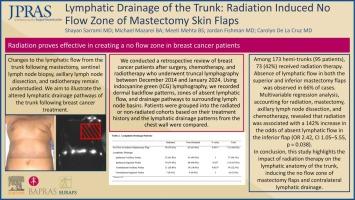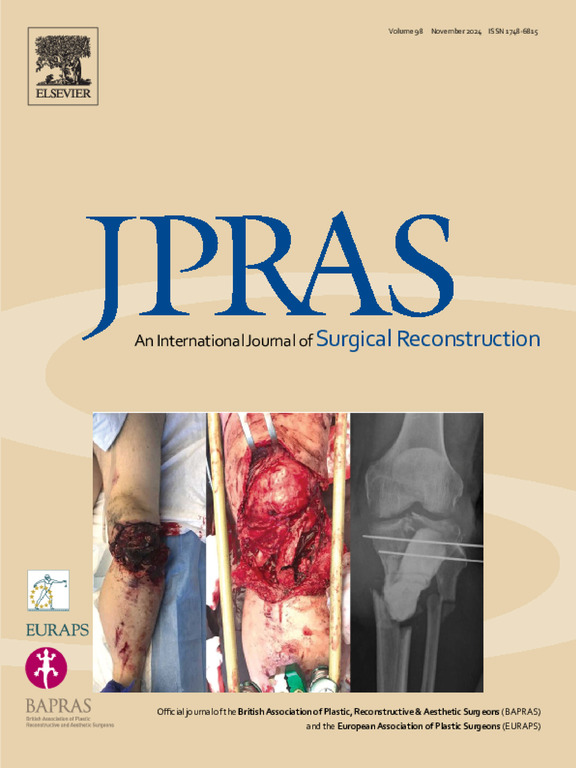躯干淋巴引流:放射诱导乳腺切除术皮瓣无血流区横断面研究。
IF 2.4
3区 医学
Q2 SURGERY
Journal of Plastic Reconstructive and Aesthetic Surgery
Pub Date : 2025-09-01
DOI:10.1016/j.bjps.2025.08.028
引用次数: 0
摘要
乳房切除术、前哨淋巴结活检、腋窝淋巴结清扫和放疗后干淋巴流的变化仍未得到充分研究。我们的目的是说明改变淋巴引流途径的干乳腺癌治疗后。我们对2014年12月至2024年1月期间接受截尾淋巴造影的乳腺癌患者进行了回顾性研究。使用标准化的成像方案,我们记录了真皮回流模式,缺乏淋巴流动的区域,以及周围淋巴结盆地的引流途径。根据患者的治疗史和胸壁淋巴引流模式,将患者分为放疗组和非放疗组。173例半躯干患者(95例)中,73例(42%)接受了放射治疗。66%的病例在上、下乳房切除术皮瓣中发现淋巴流缺失。考虑放疗、乳房切除术、腋窝淋巴结清扫和化疗的多变量回归分析显示,放疗与下皮瓣无淋巴流的几率增加142%相关(OR 2.42,可信区间为1.05-5.55,p=0.038)。此外,放疗组对侧腋窝淋巴结引流明显增加。本研究强调了放射治疗对躯干淋巴解剖的影响,诱导乳房切除术皮瓣无血流区。这些发现对重建外科医生具有重要的临床意义,因为放射性皮瓣的淋巴停滞可能会影响手术结果。淋巴专家可以利用这些知识,以优化淋巴引流从乳房切除术皮瓣使用保守和手术途径。摘要:乳腺癌放射治疗显著损害胸部淋巴通路。我们发现放疗增加了乳房切除术皮瓣内无淋巴流区的发生率。这些知识可以帮助改善癌症治疗后淋巴引流的管理。本文章由计算机程序翻译,如有差异,请以英文原文为准。

Lymphatic drainage of the trunk: Radiation induced no flow zone of mastectomy skin flaps—A cross-sectional study
Changes in the lymphatic flow from the trunk following mastectomy, sentinel lymph node biopsy, axillary lymph node dissection, and radiotherapy remain understudied. We aimed to illustrate the altered lymphatic drainage pathways of the trunk following breast cancer treatment. We conducted a retrospective review of patients with breast cancer who underwent truncal lymphography between December 2014 and January 2024. Using a standardized imaging protocol, we recorded dermal backflow patterns, zones of absent lymphatic flow, and drainage pathways to the surrounding lymph node basins. Patients were grouped into radiated or non-radiated cohorts based on their treatment history and lymphatic drainage patterns from the chest wall were compared. Among the 173 hemi-trunks (95 patients), 73 (42%) received radiation therapy. Absence of lymphatic flow in the superior and inferior mastectomy flaps was observed in 66% of the cases. Multivariable regression analysis, accounting for radiation, mastectomy, axillary lymph node dissection, and chemotherapy, revealed that radiation was associated with a 142% increase in the odds of absent lymphatic flow to the inferior flap (OR 2.42, confidence interval, 1.05–5.55, p=0.038). Additionally, the radiation group demonstrated a significant increase in contralateral axillary lymph node drainage. This study highlights the impact of radiation therapy on the lymphatic anatomy of the trunk, inducing the no flow zone in mastectomy flaps. These findings are clinically significant for reconstructive surgeons, as lymphatic stasis in radiated flaps may compromise surgical outcomes. Lymphatic specialists can leverage this knowledge to optimize lymphatic drainage from the mastectomy flap using conservative and surgical approaches.
Lay summary
Radiation therapy for breast cancer treatment significantly damages the lymphatic pathways in the chest. We showed that radiation increases the incidence of no lymphatic flow zones within mastectomy flaps. This knowledge can help improve the management of lymphatic drainage after cancer treatment.
求助全文
通过发布文献求助,成功后即可免费获取论文全文。
去求助
来源期刊
CiteScore
3.10
自引率
11.10%
发文量
578
审稿时长
3.5 months
期刊介绍:
JPRAS An International Journal of Surgical Reconstruction is one of the world''s leading international journals, covering all the reconstructive and aesthetic aspects of plastic surgery.
The journal presents the latest surgical procedures with audit and outcome studies of new and established techniques in plastic surgery including: cleft lip and palate and other heads and neck surgery, hand surgery, lower limb trauma, burns, skin cancer, breast surgery and aesthetic surgery.

 求助内容:
求助内容: 应助结果提醒方式:
应助结果提醒方式:


